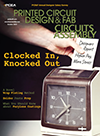Products
Horizon 02i screen printer adds a position-adjustable 15" touchscreen LCD to enhance ease of use and operational speed. Is said to achieve 1.6 Cpk at ±25 µm full paste-on-pad process capability in 12 sec. cycle time. Has up to 508 x 508 mm board size range, and is fitted with ESD-safe transport rails.
Supports the TimeToGo upgrade, for optimizing replenishment intervals for paste, paper and USC solvent, and to predict and plan machine stoppages. Is part of the Instinctiv printer family.
DEK, www.dek.com
Supports the TimeToGo upgrade, for optimizing replenishment intervals for paste, paper and USC solvent, and to predict and plan machine stoppages. Is part of the Instinctiv printer family.
DEK, www.dek.com
PCNAlert, for component event management, permits customers to receive manufacturers’ part change notices in a timely fashion.
The tool ranks manufacturers based on their notification process. With this ranking, design engineers and procurement groups can assess the risk of using parts from a particular manufacturer. It also checks manufacturers’ Websites daily looking for posted notices about part changes.
Includes AVLalert, which monitors approved vendor lists and approved manufacturer lists for product change notifications (PCNs) and end-of-life notices; and BOMverifier, an automatic on-demand BoM and parts list scrubber.
EMA Design Automation, www.PCNAlert.com.
EMA Design Automation, www.PCNAlert.com.
The PalletPal Rotator can be used to rotate fully loaded pallets, replace broken pallets, and switch to or from in-house/shipping pallets, transfer loads to slip sheets, and replace damaged goods at the bottom of a load without the need for manual restacking.
Southworth Products, www.Southworthproducts.com
Handles loads up to 48 x 48 x 60" with capacities up to 4400 lbs. Loads rotate a full 180° on a massive anti-friction turret bearing and can be stopped at any point during rotation.
Southworth Products, www.Southworthproducts.com
Press Releases
- E-tronix Hosts Webinar with Laser Wire Solutions CEO on Advancing Medical Manufacturing Through Laser Technology
- Niche Electronics Completes Transition to Enhanced Leadership Team
- Aegis Software Expands its Presence in France and Partners with STPGroup
- Altus Adds Breakthrough Automated Inline Laser Depaneling System to its Line-Up


